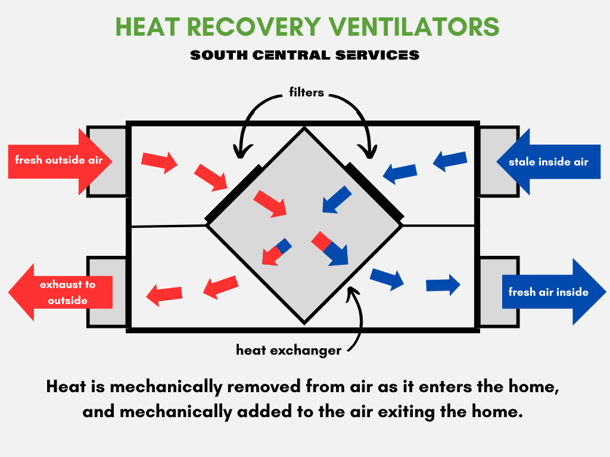How HRV Protects Against Mold and Moisture Problems
Wiki Article
Checking out the Benefits of Heat Recovery Ventilation for Power Performance in Houses
Heat Recovery Ventilation (HRV) systems use homeowners a functional strategy to enhancing power performance. By recovering heat from outward bound air, these systems can considerably decrease cooling and heating prices. Additionally, they provide a consistent supply of fresh air, enhancing indoor air top quality and convenience levels. As homeowners take into consideration sustainable choices, understanding the subtleties of HRV systems ends up being progressively vital. What aspects should one review prior to making such an investment?Recognizing Heat Recovery Ventilation Equipments

Exactly How HRV Enhances Indoor Air Top Quality

Power Cost Savings: The Financial Benefits of HRV
Taking full advantage of power performance, heat recovery ventilation (HRV) systems supply substantial economic advantages for homeowners. By recouping and recycling heat from exhaust air, HRVs significantly reduce cooling and heating costs. This innovation can bring about power cost savings of up to 30%, depending upon environment and use patterns. Property owners often observe decreased energy bills quickly after installment, making HRVs look what i found a monetarily smart financial investment in time. In addition, lots of regions provide motivations or refunds for energy-efficient upgrades, further boosting the financial appeal. As energy rates proceed to climb, the cost-effectiveness of HRVs comes to be significantly clear. On the whole, the incorporation of HRV systems not just advertises power efficiency yet likewise adds to lasting economic savings for families.The Ecological Influence of Heat Recovery Ventilation
A substantial ecological benefit of heat recovery ventilation (HRV) systems hinges on their capability to lower total energy intake. By recovering warm from exhaust air and moving it to incoming fresh air, HRV systems lessen the need for energy-intensive heating and cooling down approaches. This reduction in power demand adds to decrease greenhouse gas emissions, as less fossil gas is required to keep comfortable indoor temperatures. Furthermore, HRV systems boost interior air top quality by successfully trading stale air with fresh outside air, decreasing dependence on mechanical air conditioning systems that can hurt the environment. Generally, the application of HRV systems supports sustainable helpful site living techniques and aligns with global efforts to combat environment change by promoting energy effectiveness in property settings.
Selecting the Right HRV System for Your Home
Exactly how can homeowners assure they choose the appropriate heat recovery ventilation (HRV) system for their demands? First, they should analyze their home's dimension and layout, as these factors affect air movement needs. Next, evaluating the system's efficiency ratings is vital, as greater ratings suggest far better efficiency and power savings. House owners need to also take into consideration installment and maintenance expenses, contrasting different brands and models for value. Additionally, it's vital to review noise levels, as some systems run even more silently than others. Consulting with cooling and heating professionals can give customized referrals based upon particular home conditions. Ultimately, examining individual testimonials and service warranties can assist in making a notified decision, guaranteeing that the picked HRV system successfully boosts interior air top quality and energy efficiency.Regularly Asked Concerns

Just how Often Should I Clean or Keep My HRV System?
The regularity of cleaning or preserving a warmth recovery ventilation (HRV) system commonly depends on use and ecological elements. Usually, it is suggested to carry out upkeep every six months to assure peak performance and air quality.
Can HRV Solutions Help In Reducing Moisture Levels Inside Your Home?
HRV systems can effectively minimize indoor humidity levels by exchanging stale, damp air with fresh, drier air from outside. discover this HRV Heat Recovery Ventilation. This procedure assists keep a balanced indoor environment, improving convenience and preventing moisture-related concerns
What Is the Life expectancy of a Normal HRV System?
The life-span of a common heat recovery ventilation (HRV) system varies, typically lasting in between 10 to 15 years. Regular upkeep can extend its performance and functional life, making certain peak efficiency throughout its usage period.Are There Any Type Of Sound Interest In HRV Systems?
Sound worry about HRV systems can occur, specifically from follower operation. Lots of modern-day units are designed to lessen audio degrees, guaranteeing they operate silently while keeping effectiveness, which deals with potential disturbances in living environments.Can I Mount an HRV System Myself, or Do I Need a Professional?
The specific contemplated whether to mount the heat recovery ventilation (HRV) system directly or hire a professional. Usually, while do it yourself installment is possible, expertise warranties proper capability and compliance with local building codes, boosting system effectiveness.Report this wiki page